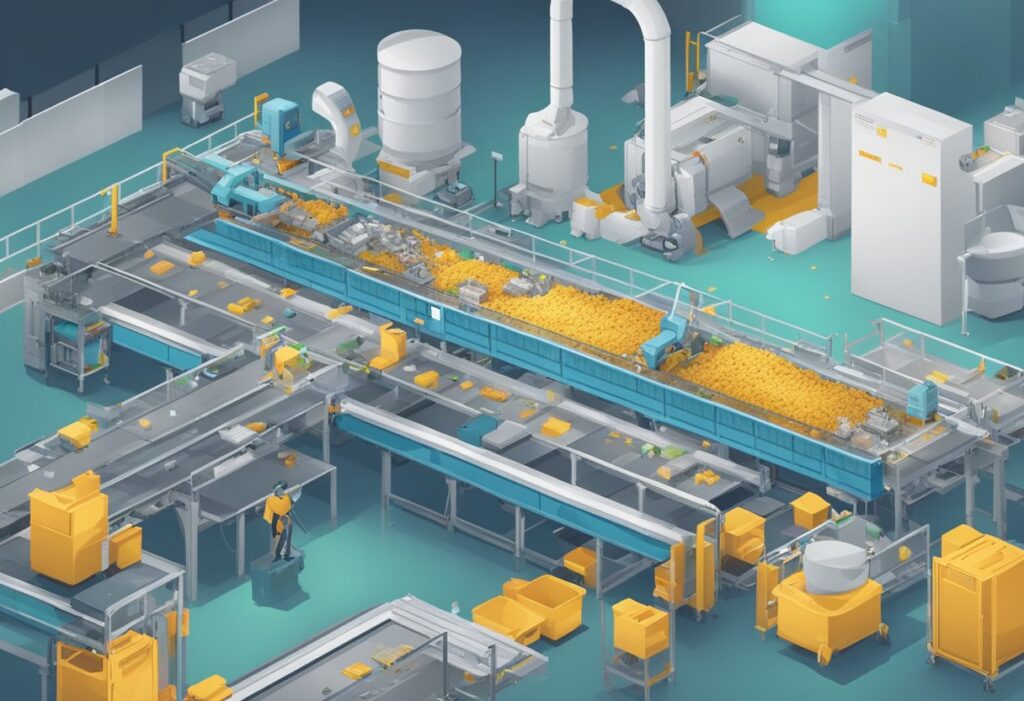Tackling Pollution Effectively

Artificial intelligence (AI) is revolutionizing industries worldwide, including waste management. With rising pollution levels and growing environmental concerns, AI offers transformative solutions for managing waste and controlling pollution. This article explores the diverse applications of AI in waste management, highlighting its potential, challenges, and future prospects.
Introduction to AI in Environmental Management
Integrating AI in environmental management represents a significant step towards sustainable development. AI’s ability to analyze large datasets, predict outcomes, and optimize processes makes it crucial for tackling pollution and improving waste management systems. As environmental degradation intensifies, leveraging AI for sustainability becomes increasingly important.
AI for Air Quality Monitoring and Control
Real-Time Air Quality Monitoring Using AI Sensors
Urban areas now deploy AI-powered sensors to monitor air quality in real time. These sensors collect data on pollutants like nitrogen dioxide, particulate matter, and sulfur dioxide. Machine learning algorithms analyze this data, providing insights into pollution patterns and sources.
Predictive Analytics for Forecasting Pollution Levels
AI-driven predictive analytics can forecast air pollution levels days or weeks in advance. This enables city planners and environmental agencies to implement proactive measures. For instance, IBM’s Green Horizons uses AI to forecast air quality, allowing cities like Beijing to take preemptive actions to mitigate pollution.
AI-Driven Air Quality Improvement Projects
Several cities have implemented AI-driven projects to improve air quality. In London, AI predicts air pollution levels and suggests traffic management strategies to reduce emissions. Breeze Technologies uses AI to provide real-time air quality data, helping municipalities make informed decisions.
AI in Water Pollution Detection and Management
AI-Powered Systems for Detecting Water Contaminants
AI technology revolutionizes water quality monitoring. AI algorithms can detect contaminants like heavy metals, pesticides, and pathogens with high accuracy. For example, the University of Waterloo developed AI models that predict harmful algal blooms, helping prevent waterborne diseases.
Automated Solutions for Water Treatment and Purification
AI-powered automated water treatment systems optimize the purification process. These systems adjust treatment parameters in real-time based on incoming water quality, ensuring safe drinking water with minimal chemical usage. Companies like Xylem pioneer AI-driven water management solutions, enhancing the efficiency and effectiveness of water treatment plants.
Protecting Water Resources with AI
AI’s role in water resource management extends to conservation efforts. AI models predict drought conditions, enabling better water resource planning. The European Space Agency uses AI to analyze satellite data, monitoring water bodies and assessing climate change impacts on water resources.

AI for Soil Pollution and Remediation
Monitoring Soil Health and Detecting Pollutants
AI monitors soil health, detects pollutants, and assesses soil quality. Machine learning models analyze data from soil sensors, providing insights into contamination levels and soil composition. This information is crucial for farmers and environmentalists to implement effective remediation strategies.
Optimizing Soil Remediation Techniques
AI-driven remediation techniques restore contaminated soils effectively. Machine learning algorithms suggest the best remediation methods based on soil conditions and contamination levels. This approach enhances remediation efforts and reduces costs.
AI in Soil Pollution Management
AI applications in soil pollution management are gaining traction globally. In India, AI monitors and remediates soil contaminated by industrial waste. Projects like SoilCares leverage AI to provide real-time soil analysis, helping farmers improve soil health and productivity.

Waste Sorting and Recycling Automation
Automated Waste Sorting Systems
AI-powered waste sorting systems transform recycling processes. These systems use computer vision and machine learning to identify and sort different types of waste, significantly improving recycling rates. Companies like AMP Robotics developed AI-driven robots that accurately sort recyclables from waste streams.
Enhancing Recycling Processes
AI enhances recycling by identifying materials difficult to recycle manually. Advanced AI algorithms recognize complex materials, ensuring correct sorting. This increases recycling efficiency and reduces contamination in recyclable materials.
Modern Recycling Facilities
Modern recycling facilities increasingly adopt AI technology. In California, AI-powered robots at Recycleye sort plastics, metals, and paper with high precision. These innovations set new standards in the recycling industry.
Smart Waste Collection and Management Systems
Optimizing Waste Collection Routes
AI-driven predictive analytics optimize waste collection routes, reducing fuel consumption and operational costs. By analyzing historical data and real-time inputs, AI systems suggest the most efficient routes for waste collection trucks. This saves time and money while reducing carbon emissions.
Smart Waste Bins
IoT and AI integration gives rise to smart waste bins that monitor fill levels and send alerts when they need emptying. These bins optimize waste collection schedules, ensuring timely disposal and reducing overflow issues. Companies like Bigbelly lead with smart waste solutions.
Improving Waste Collection Efficiency
AI benefits waste collection by improving route optimization and enhancing efficiency. Smart waste bins contribute to cleaner and more sustainable environments by ensuring timely waste disposal.
Predictive Maintenance for Waste Management Infrastructure
Forecasting Maintenance Needs
AI predicts maintenance needs for waste management infrastructure. Machine learning models analyze equipment data, forecasting potential failures and maintenance requirements. This proactive approach minimizes downtime and extends the lifespan of waste management systems.
Reducing Downtime and Costs
Predictive maintenance powered by AI reduces unexpected breakdowns, ensuring smooth operation of waste management facilities. Addressing maintenance issues before they escalate lowers operational costs and enhances system reliability.
Successful AI Implementations
Successful AI implementations in waste management include projects by Veolia and Suez. Predictive maintenance has led to substantial improvements in operational efficiency and cost savings.
AI in Hazardous Waste Management
Identifying and Managing Hazardous Waste
AI is critical in managing hazardous waste. AI systems identify hazardous materials and suggest appropriate disposal methods, ensuring compliance with environmental regulations. This reduces the risk of environmental contamination and enhances safety.
Ensuring Safety and Compliance
AI-driven solutions ensure hazardous waste is managed safely and in compliance with regulatory standards. Machine learning models assess risks associated with hazardous materials, guiding their safe disposal and treatment.
Case Studies in Hazardous Waste Management
AI applications in hazardous waste management are exemplified by companies like Clean Harbors and Stericycle. AI-driven solutions have improved safety and compliance in handling hazardous waste.
AI for Plastic Waste Reduction

Identifying and Reducing Plastic Waste
AI initiatives address the plastic waste crisis. AI models identify plastic waste sources and suggest reduction strategies. Projects like The Ocean Cleanup use AI to track and remove plastic from oceans.
Innovative Solutions for Plastic Recycling
AI solutions enhance plastic recycling processes. AI-powered systems sort plastics by type and quality, improving recycling efficiency and reducing contamination. Companies like Tomra lead AI-driven plastic recycling technologies.
Success Stories in Plastic Waste Management
Success stories in AI-driven plastic waste management include Plastic Bank. This initiative uses AI to incentivize plastic recycling in developing countries, turning waste into a valuable resource.
AI and E-Waste Management
Identifying and Recycling Electronic Waste
AI revolutionizes e-waste management by identifying and recycling electronic waste efficiently. AI systems detect valuable materials in e-waste, ensuring they are recovered and reused.
Efficient E-Waste Processing
Efficient e-waste processing is achieved through AI technologies that automate the dismantling and sorting of electronic devices. This enhances recovery rates and reduces the environmental impact of e-waste.
Managing E-Waste Challenges
Case studies in managing e-waste include projects by EcoATM and ERI. AI-driven systems have significantly improved e-waste recycling rates and environmental outcomes.
AI for Circular Economy in Waste Management
Promoting Circular Economy Principles
AI promotes circular economy principles by optimizing resource use and minimizing waste. AI systems identify opportunities for reusing and recycling materials, supporting sustainable production and consumption patterns.
Resource Recovery and Waste Reuse
AI applications in resource recovery focus on identifying valuable materials in waste streams and suggesting ways to reuse them. This approach reduces waste and supports the circular economy.
AI-Enabled Circular Economy Initiatives
Examples of AI-enabled circular economy initiatives include projects by the Ellen MacArthur Foundation. These projects leverage AI to enhance resource efficiency and sustainability.
Challenges and Ethical Considerations
Data Privacy and Security
AI applications in waste management must address data privacy and security concerns. Ensuring ethical data use and protecting sensitive information are crucial for gaining public trust and compliance with regulations.
Economic and Social Impacts
The adoption of AI in waste management can lead to job displacement due to automation. Balancing technological advancements with social considerations and retraining programs is essential for a smooth transition.
Overcoming Technical Challenges
AI implementation faces technical challenges, including the need for high-quality data and robust infrastructure. Overcoming these barriers requires investment in technology and skilled personnel.
Conclusion
AI’s impact on waste management and pollution control is profound. Its ability to optimize processes, predict outcomes, and enhance efficiency offers a promising path toward a sustainable future. Continued innovation and collaboration are key to fully realizing AI’s potential in environmental sustainability.





